The February 2025 edition of IALR at a Glance features a sleek new look that is packed with exciting news and updates! Learn more about…
- A Place for Mutual Success
- Navy’s National Training Center Opens
- Host an Intern
- Much more!
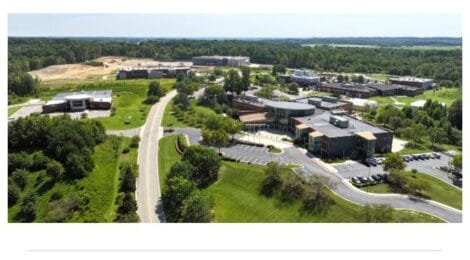
The February 2025 edition of IALR at a Glance features a sleek new look that is packed with exciting news and updates! Learn more about…
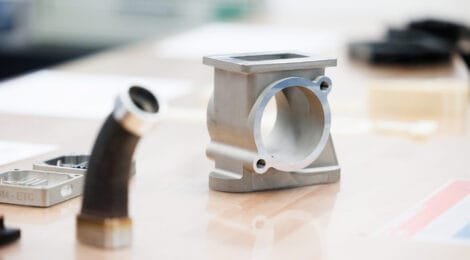
Nobody likes delays.
The stakes are even higher when a mission depends on getting the right parts at the right time. For the U.S. Navy, a delayed part can stall a mission and force a vessel to remain tied to the pier instead of patrolling the seas.
This is where the U.S. Navy Additive Manufacturing Center of Excellence (AM CoE) steps in. Housed within the Center for Manufacturing Advancement (CMA) on the Institute for Advanced Learning and Research (IALR) campus, this collaborative project reduces delays and increases part availability and production capabilities. Involving eight partners, including Austal USA and IALR, the AM CoE helps develop digital technical data packages, or “manufacturing recipes,” that activate suppliers in the Maritime Industrial Base (MIB).
This shift enables quicker turnaround times and provides the U.S. Navy with options that did not exist a few years ago. Rather than waiting on months-long casting or forging lead times, which are susceptible to a high level of quality-related issues, the Navy can distribute these recipes to qualified suppliers, speeding up production and ensuring higher quality and accuracy on each part produced.
“The AM CoE is the nexus of additive integration.” – Aaron Wiest, Additive Manufacturing Program Manager, MIB Program
As part of the MIB Program, the AM CoE project supports the Navy’s ambitious goal of producing one Columbia-class and two Virginia-class submarines annually. Achieving this build rate while simultaneously maintaining the existing fleet and supporting the recent AUKUS agreement is challenging because it requires a dependable supply of thousands of parts, both for the suppliers and at the shipyards themselves.
Many of those parts are traditionally produced using castings and forgings, which result in significant constraints on where and how many can be made.
By shifting to digital “recipes” for additive manufacturing, the AM CoE provides a more flexible path that reduces cost, time and reliance on limited foundries. These technical data packages guide approved suppliers, ensuring consistency across the supply chain. Instead of waiting on a single foundry, multiple vendors can print identical parts from the same digital file.

“When you move to a digital paradigm, you have a digital casting mold or an additive data file that allows you to use a 3D printer and manufacture the shape that you need, which will then later go through value-added processing. The CoE gets to be the repository of those files for any of the companies that wish to join in that collaborative network and support the U.S. Navy.” – Aaron Wiest, Additive Manufacturing Program Manager, MIB Program
IALR’s Center for Manufacturing Advancement supports the AM CoE’s work by providing a high-performance environment for this manufacturing optimization. Its ISO-certified CNC Machining Innovation Lab refines subtractive processes for additively produced parts, and the Precision Metrology Lab’s advanced inspection capabilities ensure quality. Both labs also serve other clients seeking process improvements. Emerging technology is tested, proven and implemented within this ecosystem for immediate impact.
The Additive Manufacturing Center of Excellence includes many partners, several of which have staff stationed on the IALR Campus full-time.
Though the AM CoE focuses on developing processes, it has swiftly produced parts to meet urgent demands. Three recent examples exemplify its ability to deliver results:
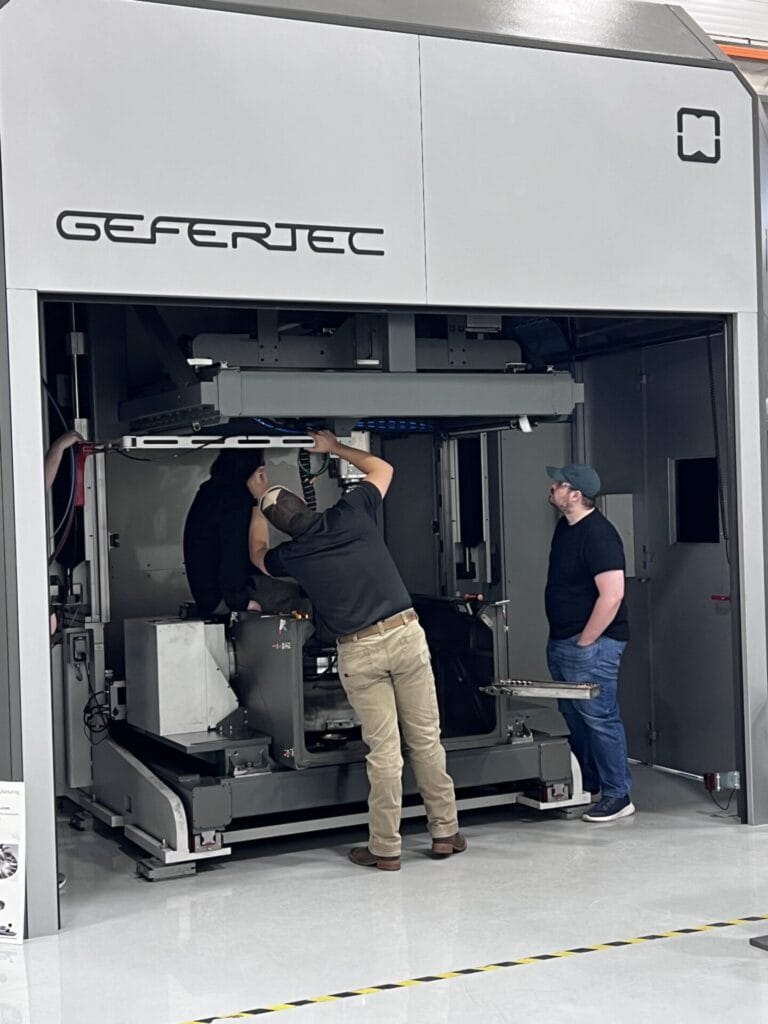
Employees of the Phillips Corporation work on a large 3D printer inside the U.S. Navy’s Additive Manufacturing Center of Excellence on the IALR campus.
A small bracket helps a destroyer’s hangar door sensor function properly. It functions like a garage door sensor–ensuring nothing is under the door before it closes.
Due to limited supply chains, a malfunctioning helo hangar door bracket on a U.S. Destroyer threatened to delay its mission for months.
Over the 2023 holiday season, the AM CoE printed, machined, inspected and delivered the bracket in under three weeks. A few months later, another request came for the same part, and the turnaround dropped to just 13 days.
“Two different destroyers went out and were able to maintain their mission because of the CoE.” – Jesse Geisbert, Advanced Manufacturing Director, MIB Program
The bracket is now a procurable item, meaning future suppliers can produce it on demand.
The interior liner for a submarine’s trash disposal is certainly not glamorous and may seem insignificant, but it is integral to submarine operations. During underwater missions, submarines compact waste and securely store it in sealed metal containers, which are then safely released into the ocean.
Six of these large trash disposal liners units were delivered to a shipbuilder producing a submarine in 2024, and all six were defective and could not be used.
“It’s a very hard to cast alloy, somewhat complex part, and they didn’t have a path forward, which meant stalled submarine construction for one piece,” Wiest said.
In just nine days, the AM CoE modeled and printed a first article of manufacture. In contrast, a cast part would have taken months to deliver. This solution is expected to restore momentum and prevent submarine construction from grinding to a halt.
Aging ships and submarines like the USS Michigan also rely on critical parts, many of which are no longer produced by traditional methods. The Michigan is a 42-year-old submarine, and its trim and drain valves, especially the tailpiece, regularly corrode due to operational conditions.
The AM CoE printed the tailpiece using both laser powder bed fusion and wire arc methods, creating multiple additive manufacturing data files. This dual approach provides flexibility, ensures future availability and supports other classes of submarines that use similar components. Instead of uncertain wait times for casting or forging, the Navy now has proven digital recipes to quickly produce these vital parts when the next repair cycle comes around.
“In one place now, we’ve created two different AM data files that can be distributed,” Geisbert said. “The Ohio class will be around still for quite a considerable amount of time, and now we have a better way to produce these trim and drain valves when they need to be replaced.”
How to best print the part is only one part of the digital recipes provided by the AM CoE. The AM CoE also provides instructions on post-printing machining, metrology and measurement techniques and heat treatment.
“The CoE project has end-to-end capabilities. The team provides data on how to take an additive part through all the various steps, like machining and heat treatment, to make it a finalized, finished component. We learn things at each one of those stages that we can implement into a more well-rounded and complete end-to-end strategy.” – Jason Wells, Executive Vice President, Manufacturing Advancement, IALR
In addition to what’s happening in the AM CoE, skilled workers are trained at the adjacent Accelerated Training in Defense Manufacturing (ATDM) program. This program prepares workers for the Maritime Industrial Base, ensuring a talent pipeline ready to operate cutting-edge equipment. A spinoff of ATDM that is also located on the IALR campus, the Naval Aviation School for Additive Manufacturing (NASAM) program trains active-duty Navy personnel to use additive manufacturing equipment and techniques on ships and submarines.
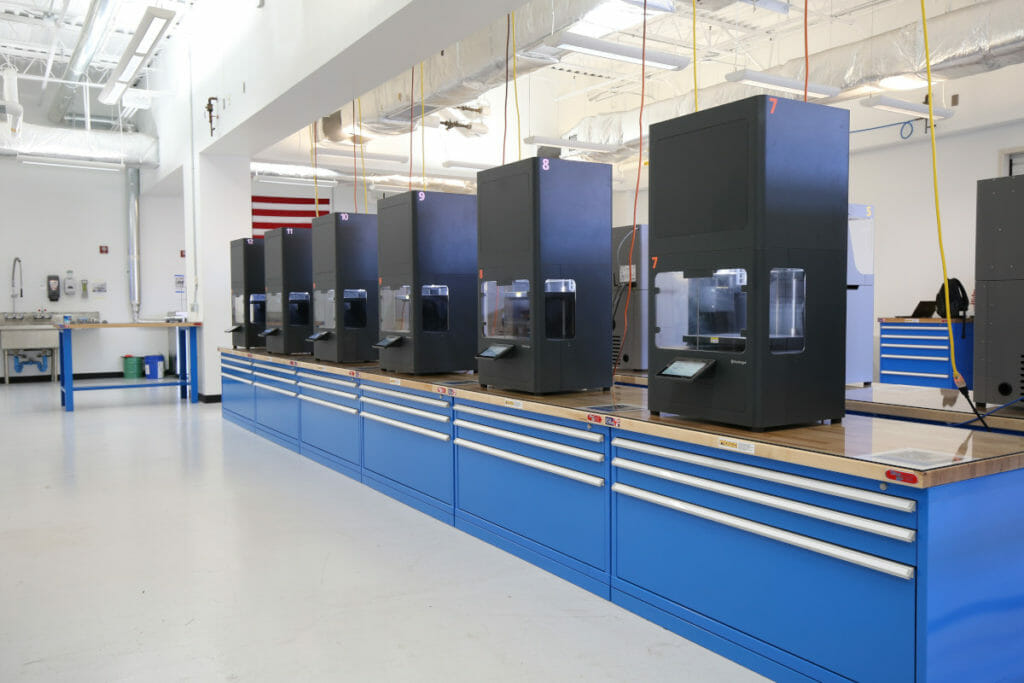
“The AM CoE is a one-stop shop for industry to come learn about additive, get qualified, understand the Navy requirements.” – Jesse Geisbert, Advanced Manufacturing Director, MIB Program
The AM CoE is a unique public-private partnership where industry, academia and government work together toward a common goal. This collaborative approach maximizes resources, knowledge sharing and innovation. Instead of operating in separate silos, partners pool their expertise and align their efforts, ultimately strengthening the entire industrial base.
“We have an era of unprecedented collaboration,” Wiest said. “It is amazing to see companies willing to jump in, willing to share some of their IP actually to help the industrial base grow.”
This kind of cooperation ensures that if one supplier faces delays, another can step in, preventing bottlenecks. Over time, the public-private partnership model builds resilience, scalability and trust across the network of suppliers and shipbuilders supporting the U.S. Navy.
“The AM CoE is that connective tissue for the OEMs and the shipbuilders and the industrial base at large.” – Jesse Geisbert, Advanced Manufacturing Director, MIB Program
The three success stories highlight how critical this work has become. A hangar door bracket was delivered in under three weeks, a trash disposal unit liner was produced in days rather than months, and a valve component for an aging submarine was quickly developed.
However, the goal of producing these digital recipes is to have even more success stories where approved suppliers utilize an existing recipe to produce needed parts on demand.
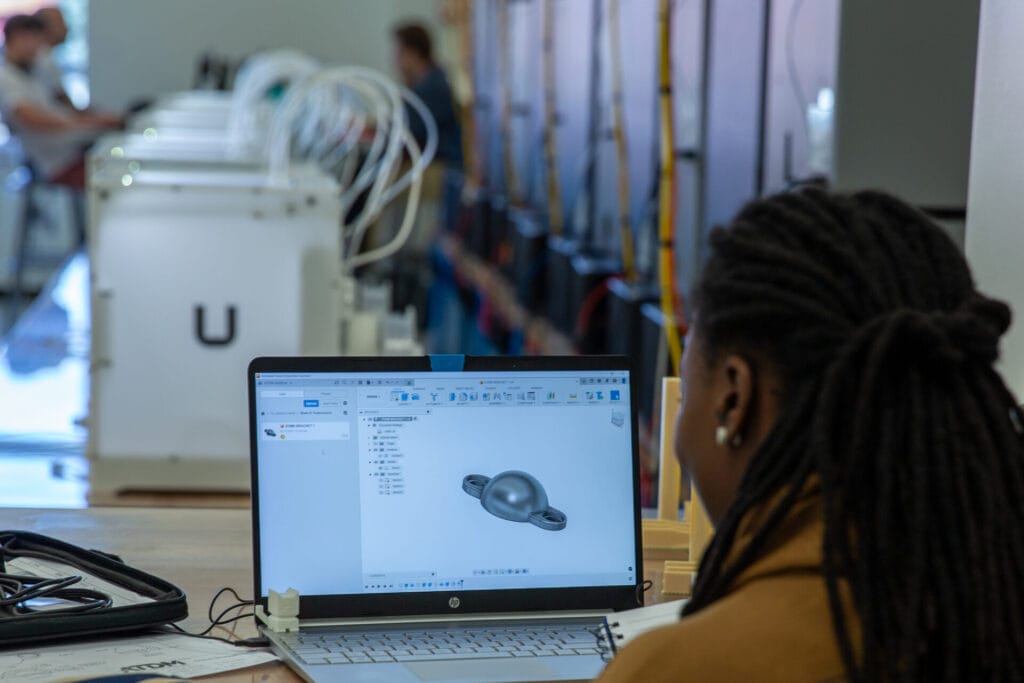
Each success means more time at sea, more deterrent strength and more efficient use of national resources. The Navy’s ambitious goals, the expansion of additive manufacturing and the AM CoE’s model all point to a future with fewer delays and heightened readiness.
“The AM CoE is a model,” Geisbert said. “Nothing is stopping us from creating something like the CoE, operated by public-private partnerships and intended for production outside every shipyard.”
The CMA’s mission to help manufacturers integrate technology and optimize processes extends beyond the Navy. It reflects a broader push for more innovative, faster and resilient manufacturing across various industries.

The December 2024 edition of IALR at a Glance is jam-packed with exciting news and updates! Learn more about…

The U.S. Navy’s Additive Manufacturing Center of Excellence (AM CoE), a linchpin in maritime technological advancement, is located inside the Center for Manufacturing Advancement on the IALR campus. This episode highlights the AM CoE as a collaborative hub of strategic importance in meeting the U.S. Navy’s ambitious submarine production goals. This project is driving manufacturing innovation forward.
IALR Executive Vice President of Manufacturing Advancement Jason Wells is joined by Advanced Manufacturing Director Jesse Geisbert and Additive Manufacturing Program Manager Aaron Wiest, both from the Maritime Industrial Base (MIB). They discuss the impact of the Navy’s AM CoE and the success stories where the project has prototyped and delivered mission-critical parts for ships and submarines much quicker than traditional methods, such as castings and forgings, and supply chains could have. This informative discussion includes:

The “Inside IALR” team showcases the CNC Innovation Lab inside the Center for Manufacturing Advancement (CMA) with CMA Operations Manager Kevin Thompson and CNC Technologist Jeremiah Williams. This episode highlights how the 5,791-square-foot CNC Machining Innovation Lab enables new and existing businesses to evaluate their processes, build out improvements and incorporate efficiencies without disrupting current operations. This space empowers manufacturers to increase global competitiveness (02:44). They discuss the role of CNC machining (04:18) and its primary role within the manufacturing industry (06:06). The equipment and processes (08:27) are the main attraction for industry. Kevin and Jeremiah explain the specific services provided by the CNC Innovation Lab (14:46) and also provide a short explanation of the Navy’s Additive Manufacturing Center of Excellence (AM CoE) and how the CNC Lab fits into that (19:14).
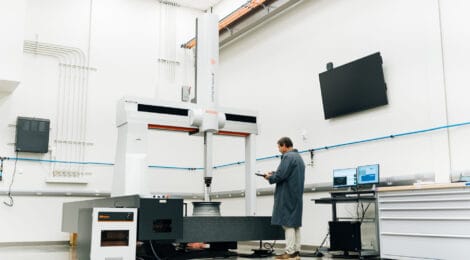
That’s how many points are scanned per second on the laser scanner on the Mitutoyo Crysta-Apex V163012 Coordinate Measuring Machine (CMM), one of the largest on the East Coast. Even a relatively small part has tens of millions of scannable points. In addition to the laser scanner, the CMM boasts a variety of unique qualification and measurement capabilities.
Equipped with the CMM and a bevy of other top-tier qualification tools and equipment, the Institute for Advanced Learning and Research’s (IALR) Metrology Lab provides critical measurement and qualifications services for the Navy’s Additive Manufacturing Center of Excellence (AM CoE) and has the capability to provide support for private industry. Located inside the Center for Manufacturing Advancement in Southern Virginia, the Metrology Lab with NIST Certified Inspection is the result of strong partnerships. IALR owns the equipment and space, but applications engineers with Mitutoyo and Master Gage & Tool Co. operate the equipment.
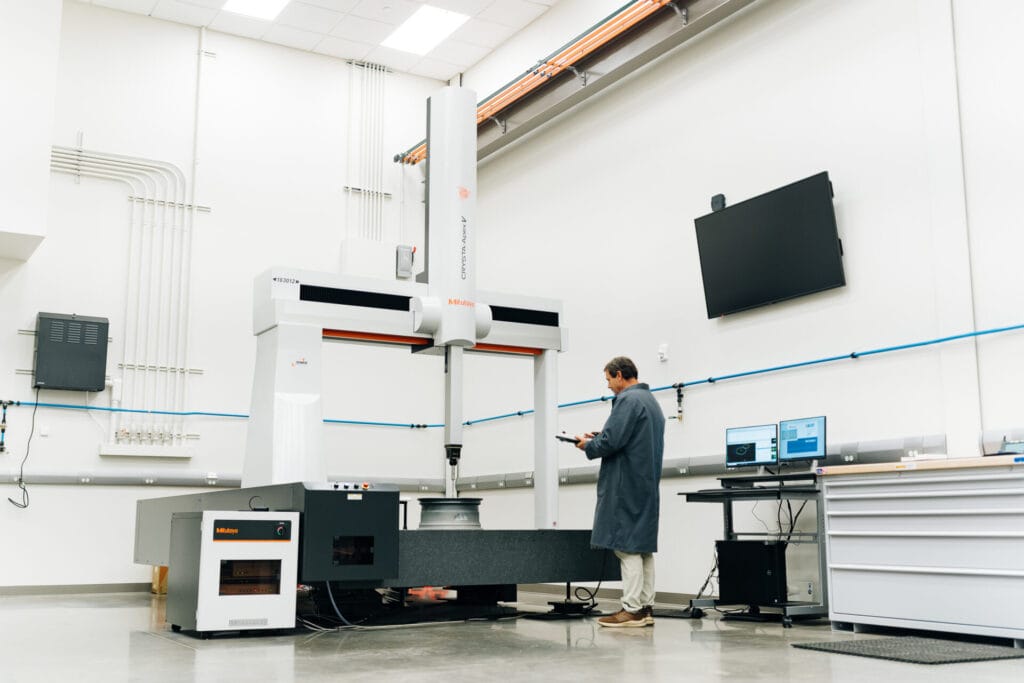
“The Metrology Lab is a unique resource for local industry and a key component of the Navy’s efforts to improve additive technologies and processes. The Metrology Lab also epitomizes several core tenets of IALR, including our mission of economic transformation, commitment to partnerships and penchant for utilizing state-of-the-art technology.” – Tim Robertson, Chief Operating Officer, Manufacturing Advancement
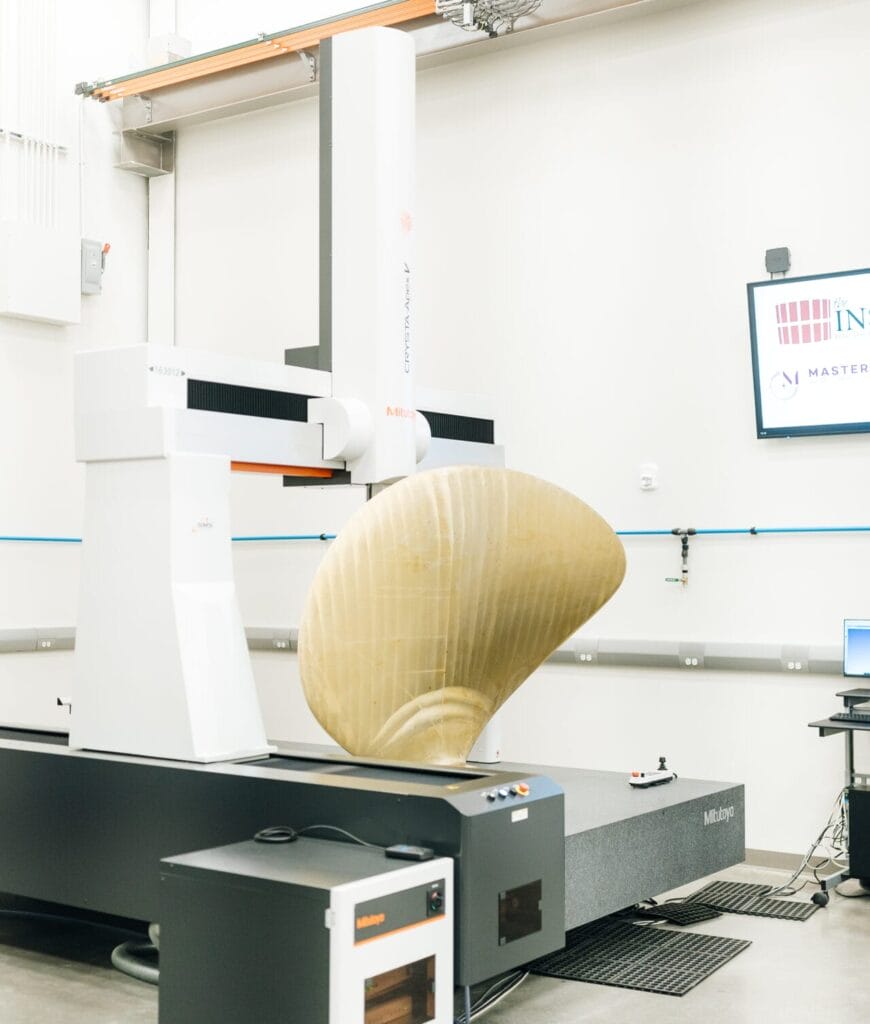 Top-Tier Metrology Through Partnerships
Top-Tier Metrology Through PartnershipsMetrology, officially defined as the science of measurement, is a crucial element of any manufacturing process. In the Metrology Lab at IALR, application engineers can perform relatively simple measurements, such as physical dimensions, and highly complex qualifications of factors like shape, hardness and many other physical qualities.
The CMM inside the Metrology Lab can perform some of the most sophisticated yet critical measurement and qualification processes possible. It has a work area that can accommodate pieces as large as five feet wide, nearly 10 feet long and almost four feet tall, but the space can also be used for smaller parts. For instance, staff could place dozens of the same parts on the surface area and program the CMM to perform identical qualification tasks on each.
“The Mitutoyo Crysta-Apex V163012 Coordinate Measuring Machine can pretty much do any type of inspections that would be needed in the industry.” – Carlos Cabello, Applications Engineer, Mitutoyo
Every measurement the machine makes is down to the micron.
Some of the services offered by the Metrology Lab with NIST Certified Inspection include:
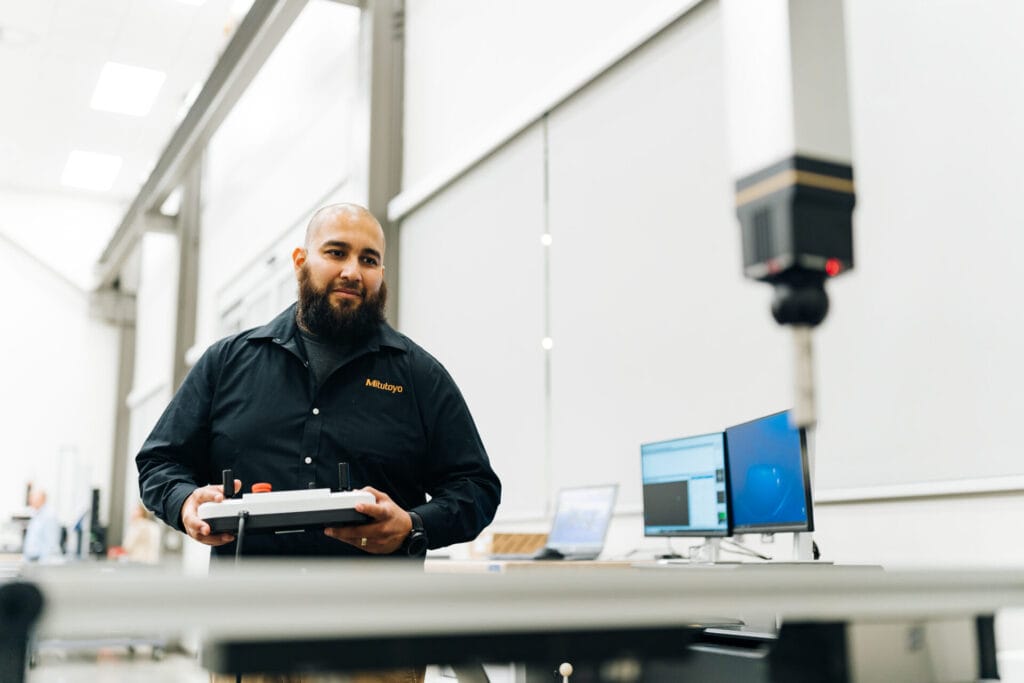
The Navy established its Additive Manufacturing Center of Excellence (AM CoE) inside the CMA. Tasked with scaling and maturing additive technologies for the production of submarine components to bolster naval shipbuilding and repair supply chains, the AM CoE includes the Navy and nine other organizations. The AM CoE team develops new technical data packages (TDP), which are essentially comprehensive “recipes” for utilizing additive manufacturing, or 3D printing, techniques to manufacture particular components.
The Metrology Lab – as well as the CNC Machining Innovation Lab that IALR owns and operates – plays a critical role in this operation. In fact, the team in the Metrology Lab will conduct three separate inspections of every part:
“It’s very honorable work, and I’m very proud to be a part of this project.” – Sean Cobb, Master Gage and Tool
While the AM CoE utilizes the lab to complete numerous inspections, the partners can also use the equipment to provide services and support to industry. The CMM and other equipment allows industry in need of testing support to accurately and affordably measure and certify products.
“In order for a company to do this level of measurement and qualification, they’re going to have to make major capital investments and slow down production. We can provide those testing services in a convenient and certified way without impeding production.” – Kevin Thompson, CMA Operations Manager
The Center for Manufacturing Advancement, which houses the Navy’s AM CoE and impactful technology and resources like the Metrology Lab, is located in Danville, Virginia, on the IALR campus. Companies that are interested in partnering with IALR in the CMA by utilizing the services of the Metrology Lab, collaborating with the CNC Innovation Lab, or learning about automation in the Industry 4.0 Integration Lab should contact the IALR team.
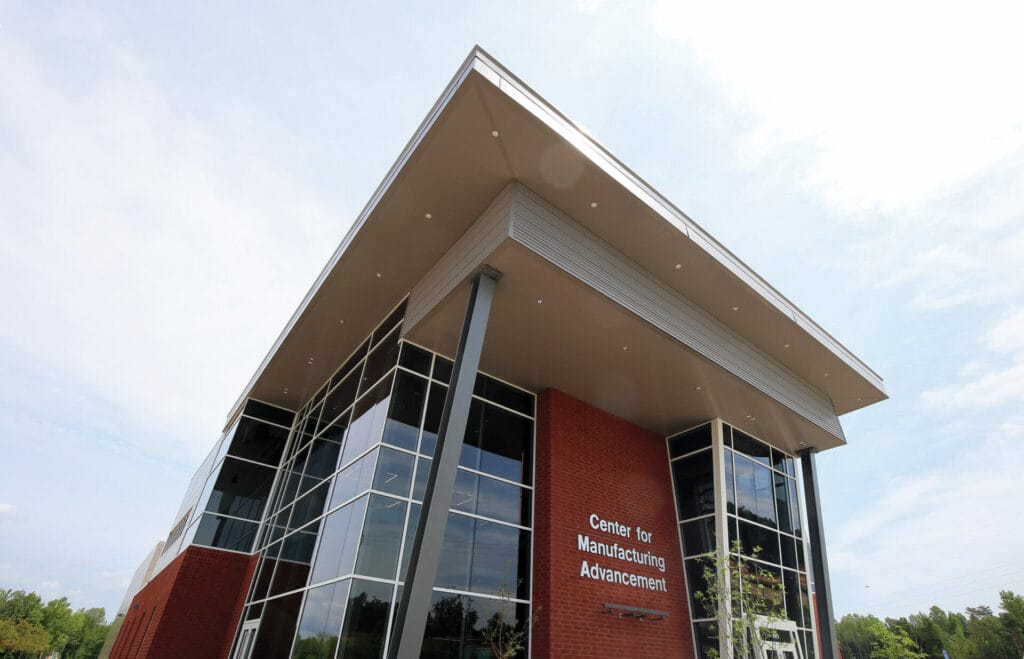
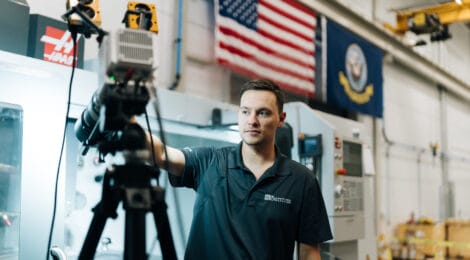
A specialized camera that shoots up to 400,000 frames per second, allowing true slow-motion views of the manufacturing process.
Cutting-edge sensors that measure factors like cutting force and harmonic vibrations.
Infrared cameras that show temperature patterns throughout an operation.
These are just a few of the specialized pieces of equipment within the Computer Numerical Control (CNC) Machining Innovation Lab, which is housed inside the Institute for Advanced Learning and Research’s (IALR) Center for Manufacturing Advancement (CMA). The CNC Machining Innovation Lab also plays a crucial role in the U.S. Navy’s Additive Manufacturing Center of Excellence (AM CoE), also housed within the CMA.
Featuring state-of-the-art equipment and cutting-edge technology, the CNC Machining Innovation Lab will support private industry through testing services and process optimization and help the AM CoE develop world-leading additive manufacturing “recipes” for the development of parts needed by the U.S. military.
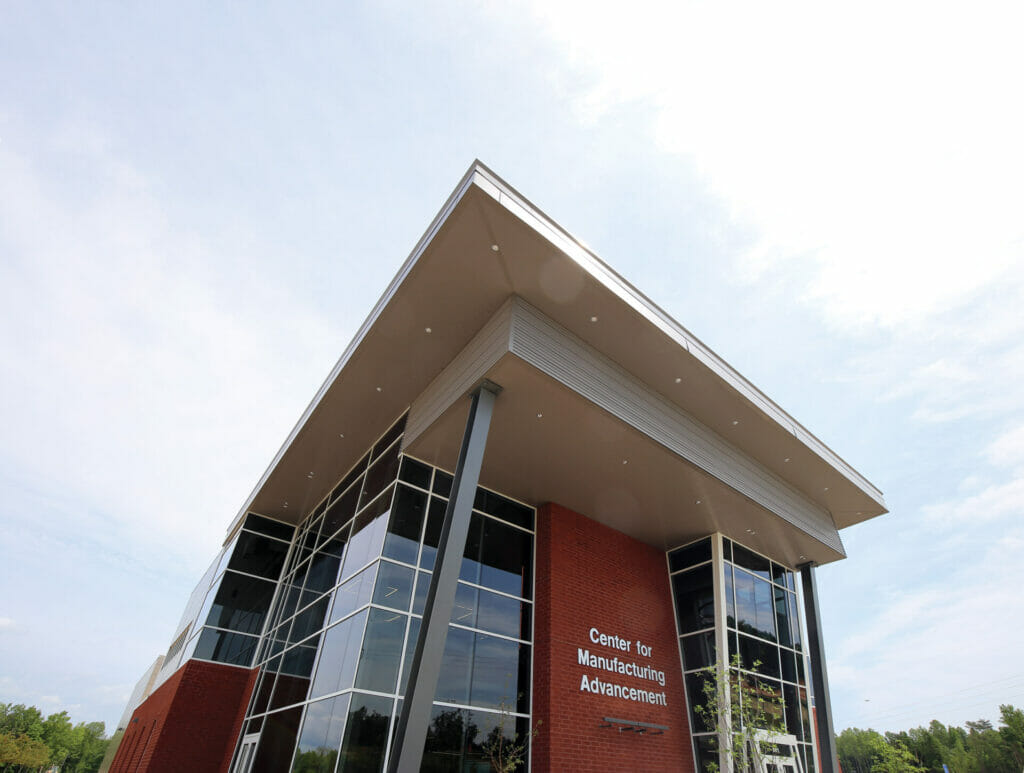
“The vision of the CNC Machining Innovation Lab is twofold. We support the AM CoE, but we also have a vision to support industry. We’re trying to develop partnerships to help industry drive innovation and productivity with increased profitability in a rapidly changing environment.” — Kevin Thompson, Operations Manager for the Center for Manufacturing Advancement, IALR
Computer Numerical Control (CNC) Machining is a manufacturing process where computer-controlled machines create precise and intricate parts and components. Commonplace in industries such as aerospace, electronics and healthcare, this is a subtractive manufacturing process – meaning that an existing block or item is whittled down or shaped.
The CNC Machining Innovation Lab partners with public and private manufacturers of all sizes to modernize their processes, identify and integrate emerging technologies and provide data-driven process development and optimization. Some of the capabilities include process development, process optimization, CNC programming, the integration of emerging technology, automation integration, turn-key solutions and application engineering support.
“Companies don’t have the capacity to be able to stop and try a new process. They have to find external ways of doing that, and that’s a huge role we can play. Companies can present a challenge to us and continue to produce goods while we develop a solution that suits their needs.” — Jeremiah Williams, CNC Technologist, IALR
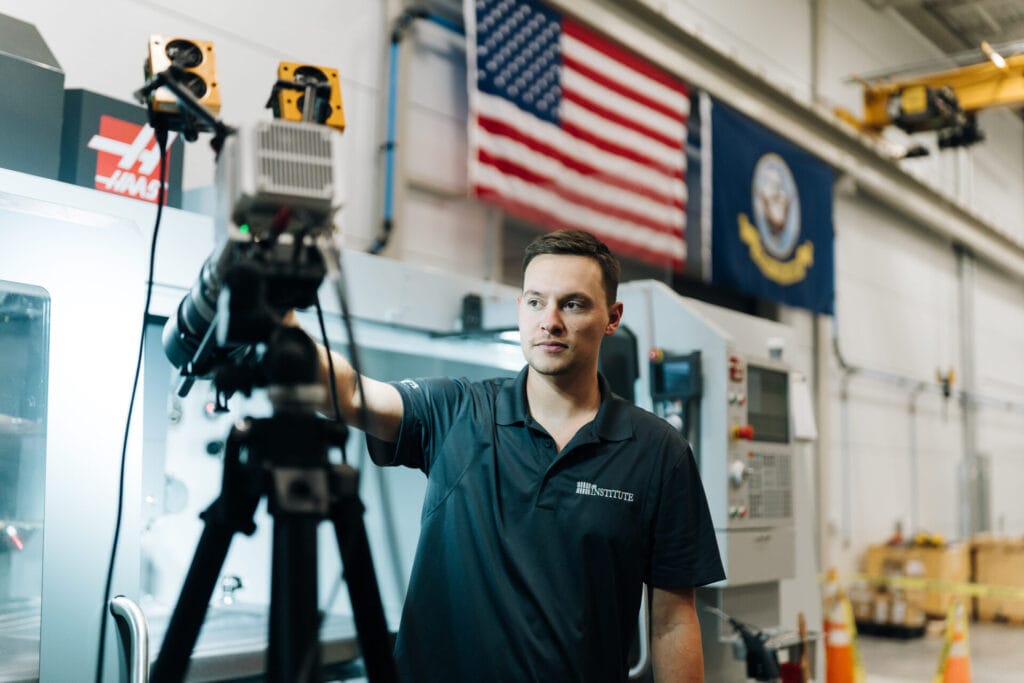
The CNC Machining Innovation Lab boasts a broad inventory of specialized equipment, including sensors to measure factors like cutting force, slow-motion cameras to track chip formation, infrared cameras to analyze the impact of heat and much more, all with the goal of “trying to optimize processes for customers,” Thompson explains. IALR is even allowing other companies to test and utilize specialized sensors inside of the CNC Lab machines for data collection.
“Our job is not to compete with industry. Our job is to support industry.” – Kevin Thompson, Operations Manager for the Center for Manufacturing Advancement, IALR
Businesses can:
The CNC Machining Innovation Lab is ISO 9001:2015 compliant, reassuring customers and partners alike that we have an internationally validated system in place to address and prevent quality issues.
The CNC Machining Innovation Lab is located across from the CMA’s state-of-the-art Metrology Lab that features one of the largest Coordinate Measuring Machines (CMM) on the East Coast with 3D scanning capability along with optical measurement systems, hardness and roundness testers and support equipment. Through a partnership with Mitutoyo and Master Gage & Tool, IALR offers the services of the Metrology Lab to regional businesses and partners who may not otherwise have access to such capabilities.
“The Metrology Lab is ideal for emerging or developing businesses to have access to this capability while building justification for their own capital investment.” – Kevin Thompson, Operations Manager for the Center for Manufacturing Advancement, IALR

“Everything we do at IALR involves partnerships and is driven by the needs of industry. Through the CNC Machining Innovation Lab and the Metrology Lab, IALR is simultaneously contributing to our nation’s defense and supporting current, new and prospective companies in Southern Virginia with needed services.” – Telly Tucker, IALR President
The CMA also includes a dynamic Industry 4.0 Integration Lab that serves as a demonstration site, showing manufacturing companies what is possible. Companies that are interested in partnering with IALR in the CNC Machining Innovation Lab or in the CMA should contact the IALR team.
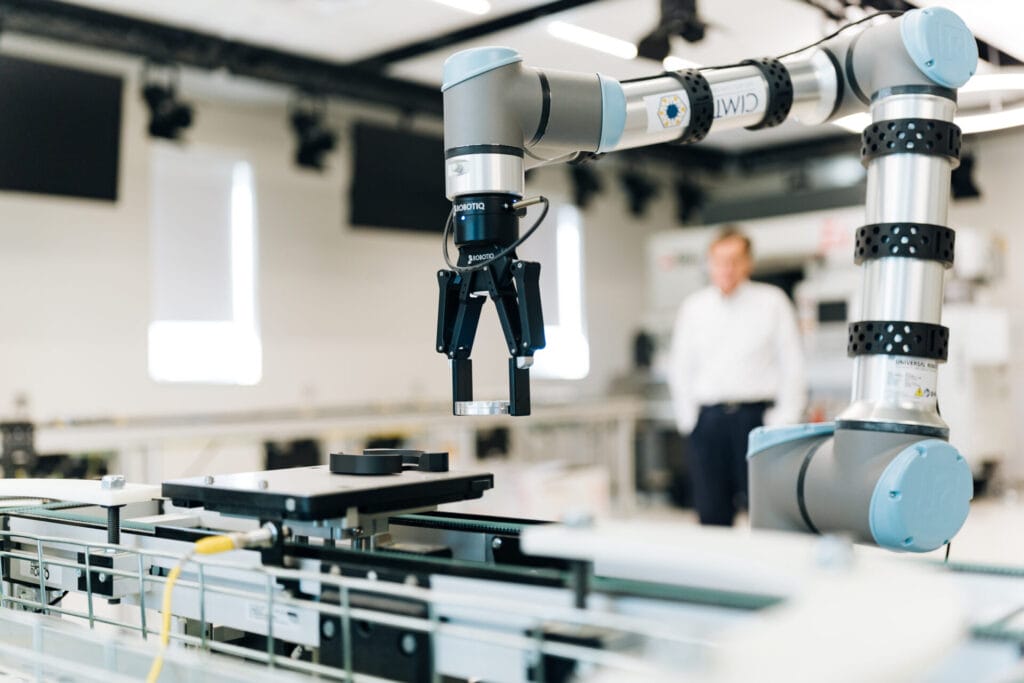
The submarine industrial base (SIB) is a system of thousands of companies that produce parts and equipment used in the production and maintenance of submarines for the U.S. Navy. IALR has partnered with the U.S. Navy – along with many other public and private organizations – in a two-pronged approach to support the SIB, the development of new submarines, and the maintenance of the existing fleet: the federal Accelerated Training in Defense Manufacturing (ATDM) program and the U.S. Navy’s Additive Manufacturing Center of Excellence (AM CoE).
ATDM increases the pool of skilled labor in areas like additive manufacturing, CNC machining, welding, metrology and non-destructive testing – trades that are needed by the SIB. On the other hand, the AM CoE is focused on implementing additive technologies and processes that will allow for more efficient development of parts. Don Hairston, General Manager of Austal USA Advanced Technologies, used the analogy of making cookies during a recent presentation at the ATDM AM CoE Summit at IALR. When making cookies and especially in manufacturing parts for the U.S. Navy, each of these variables must be accounted for and done correctly for successful production: raw materials, equipment, manufacturing know-how, post-processing and finishing and quality control.
In the simplest terms, “scaling the supply chain” is one of the primary goals of the AM CoE, Hairston explained.
The AM CoE will scale and mature additive technologies that enable innovative production of submarine components to bolster naval shipbuilding and repair supply chains. Involving nine different partners, the AM CoE will increase overall manufacturing capacity and close the supply-demand gap in critical markets like castings, forgings, fittings and fasteners.
The AM CoE team will develop new technical data packages (TDP), which are essentially comprehensive “recipes” for how to utilize additive manufacturing techniques to manufacture particular components. The workflow inside the AM CoE will typically go something like this:
As part of the Navy’s AM CoE, the CNC Machining Innovation Lab will be utilized after the initial printing of a part, verifying that the design used for additive manufacturing can successfully be machined. Simultaneously, the IALR team will also explore and implement advanced strategies that better align with today’s manufacturing equipment and methods.
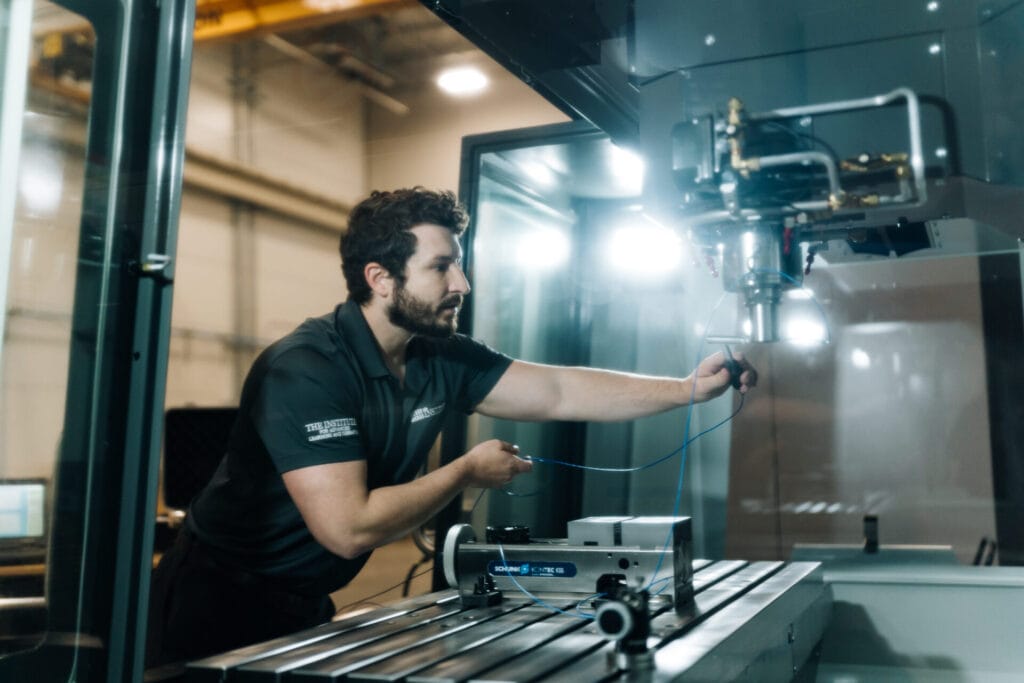
“Basically, what we will do is verify that the part that has been printed can be successfully and correctly machined without any issues.” – Jeremiah Williams, CNC Technologist
Additive manufacturing, which can also be referred to as 3D printing, is a subset of manufacturing where an object is built “from the ground up” based on a 3D model. It may seem odd that a subtractive manufacturing method would play such an integral role in the Navy’s additive manufacturing operations. While 3D printing and additive manufacturing are the primary focus of the AM CoE, subtractive methods are still essential in creating and verifying any part.
“With the current technology and dimensional requirements of the parts, you can’t simply print and install a component. You’re going to have to print it and then do some final subtractive work before the part can be utilized.” – Jeremiah Williams, CNC Technologist
Once perfected and tested, the TDPs will be shared with Navy suppliers, providing them with the “recipe” they need to produce the part correctly and efficiently. As of mid-October, the AM CoE has released 28 TDPs to the companies that will be manufacturing the parts.
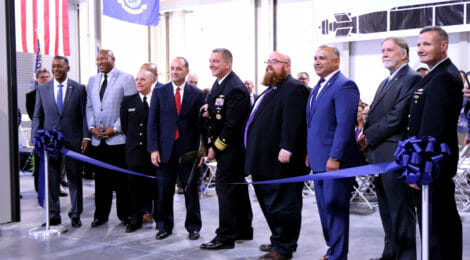
Joint Navy-OSD Accelerated Training in Defense Manufacturing Program to Benefit from new Multi-Million-Dollar Training Facility
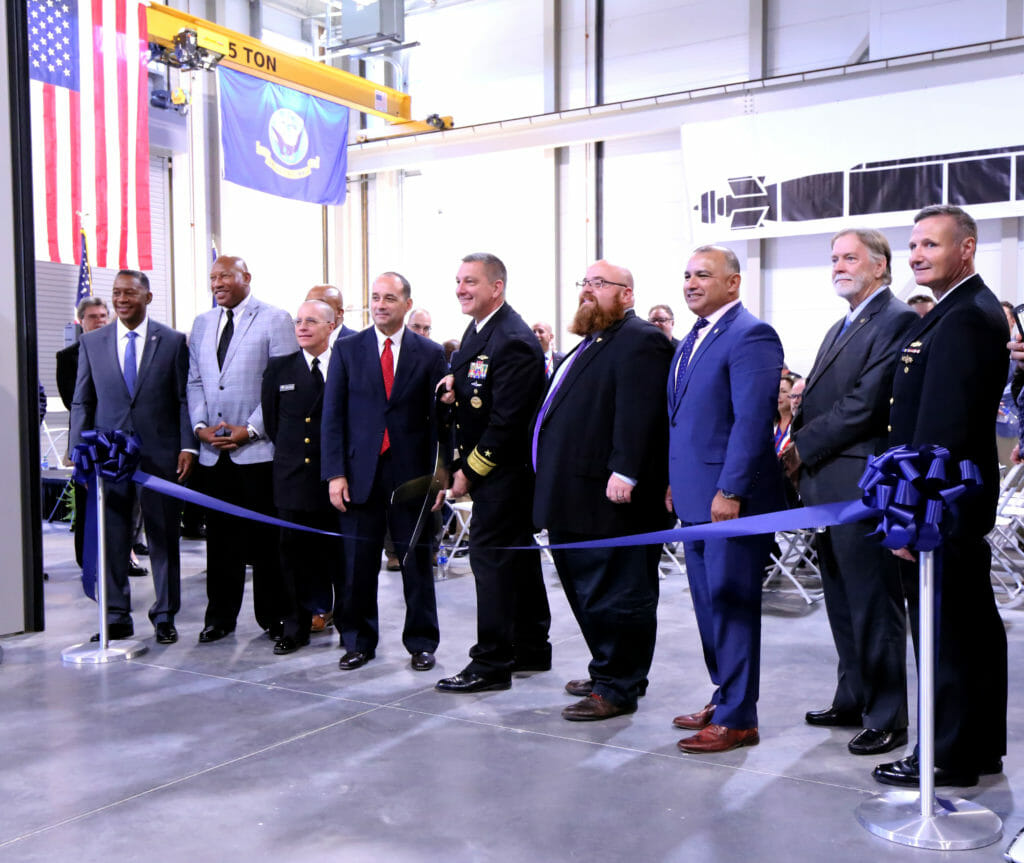
The U.S. Navy is launching its Additive Manufacturing Center of Excellence (AM CoE) within the State of Virginia’s Center for Manufacturing Advancement (CMA) on the Danville Institute for Advanced Learning and Research (IALR) campus. The creation of the AM CoE marks the first project partnership for the CMA. It demonstrates the Navy’s commitment to investing in and delivering the skilled workforce necessary to strengthen and expand the Navy’s industrial base to achieve the Nation’s strategic defense objectives.
A first for the Navy, the AM CoE will provide a platform for training a skilled additive manufacturing workforce through partnership with the Accelerated Training in Defense Manufacturing (ATDM) program, a rigorous, focused 24/5 training schedule that graduates student cohorts every four months in multiple disciplines critical to the defense industrial base (DIB). Industrial manufacturing partners include major shipbuilders like General Dynamics Electric Boat, Huntington-Ingalls Newport News Shipbuilding, Austal USA as well as key industry experts like Phillips Corporation, Industrial Inspection and Analysis, FasTech, Mitutoyo, and Master Gage & Tool, to bring multiple processes utilized by the DIB under one roof to improve efficiencies and reduce barriers to entry for manufacturers hoping to enter additive manufacturing.
Utilizing three full bays dedicated to accelerating and scaling additive manufacturing parts and qualification processes, the AM CoE’s principal functions will be to:
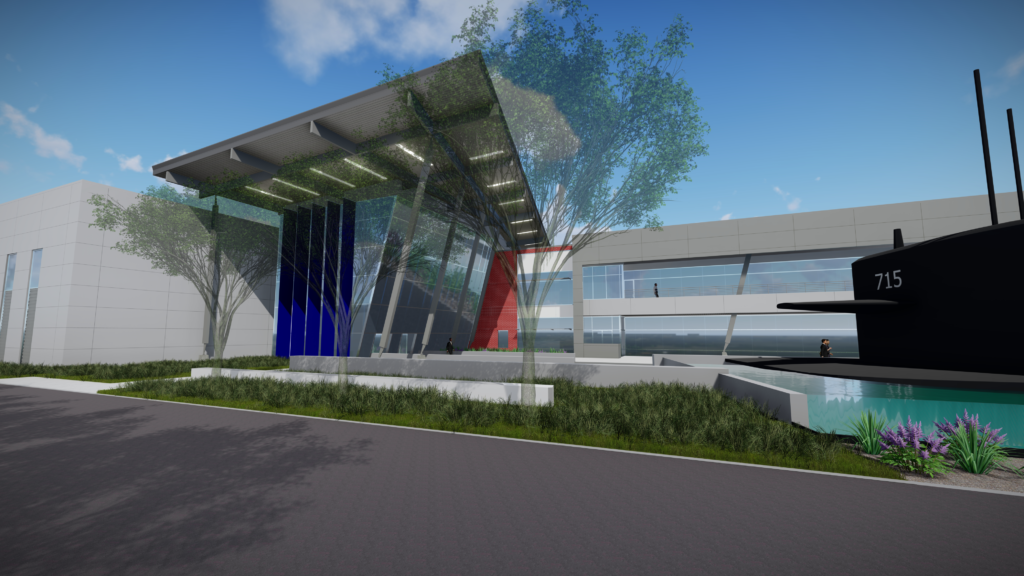
“Building and sustaining the Navy’s defense industrial base workforce has become a national security imperative, and the demonstration of partnership and collaboration that is represented here in Danville, Virginia today is part of the ‘Whole Government, Whole of Industry’ approach that must be in place to ensure the domestic manufacturing capacity that is required to maintain the Navy’s maritime edge, and surge to meet a dynamic threat environment,” said Matt Sermon, Executive Director, PEO Strategic Submarines.
A ribbon-cutting ceremony for the AM CoE was held during the second annual ATDM Summit where the U.S. Navy, Office of the Secretary of Defense, and additional federal, state and local government officials joined with partners from defense industry and academia to convene topics pertaining to closing skills and workforce gaps within the naval defense industrial base.
During the ceremony, the announcement was also made that the ATDM program, which aims to provide 800-1,000 qualified candidates to fill critical vacancies in the DIB annually by 2024, will expand with the creation of a regional training facility adjacent to the CMA. The multimillion-dollar investment into over 100,000 square feet of dedicated training capability, capacity, and infrastructure will enable ATDM to rapidly scale up to its full potential and add to the economic momentum in Southern Virginia. The Danville and Pittsylvania County Regional Industrial Facility Authority provided land for the initiative.
“The launch of the AM CoE and the announcement of scale-up potential for ATDM go hand-in-hand with IALR’s approach to support the technological and workforce development needs of Industry. We are excited to leverage our new Center for Manufacturing Advancement and work with the Navy and other partners,” said Telly Tucker, President, IALR. “ATDM is one of the strongest examples of what full integration of industry in the training process looks like, by bringing key partners together to be vested in the time-to-talent process and ensuring the unique requirements of shipbuilders and suppliers are achieved quickly to meet the demands of our nation’s defenses.”
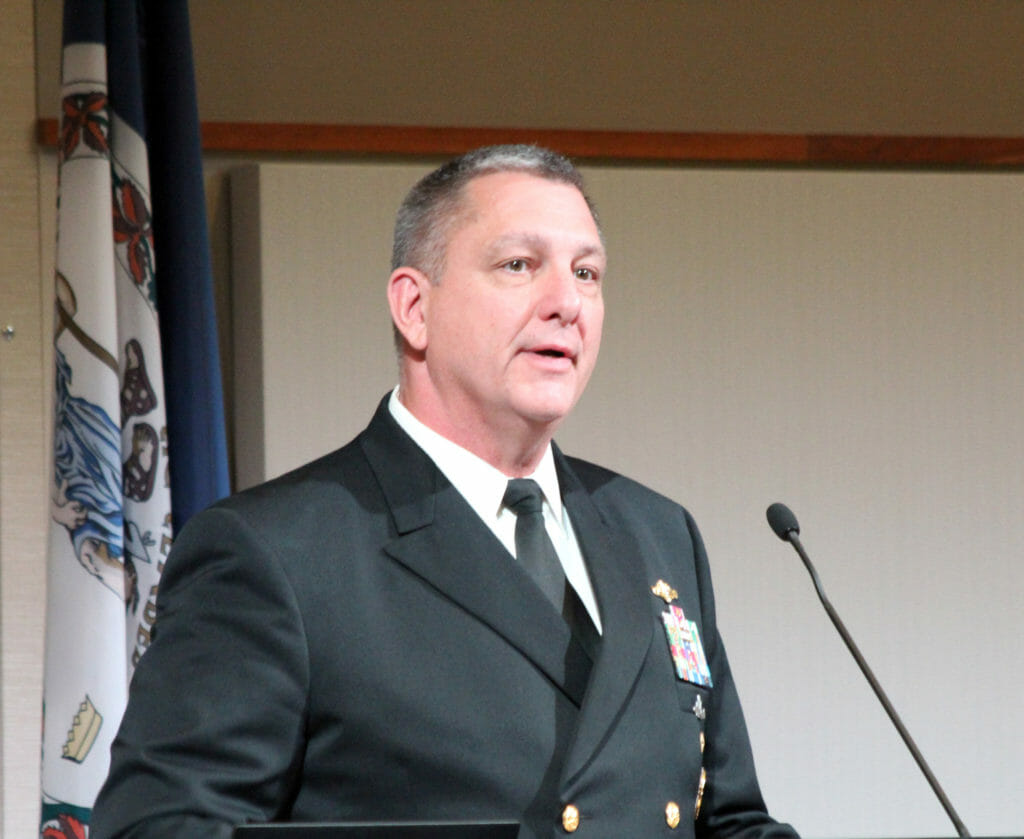 “The events we celebrate today – centered on workforce, technology, and the space where those two priorities must meet – are game changing. The scale and urgency needed in these areas is a fundamental differentiator in our Navy’s ability to preserve peace, and when necessary, compete and win,” added RADM Scott Pappano, PEO Strategic Submarines.”
“The events we celebrate today – centered on workforce, technology, and the space where those two priorities must meet – are game changing. The scale and urgency needed in these areas is a fundamental differentiator in our Navy’s ability to preserve peace, and when necessary, compete and win,” added RADM Scott Pappano, PEO Strategic Submarines.”